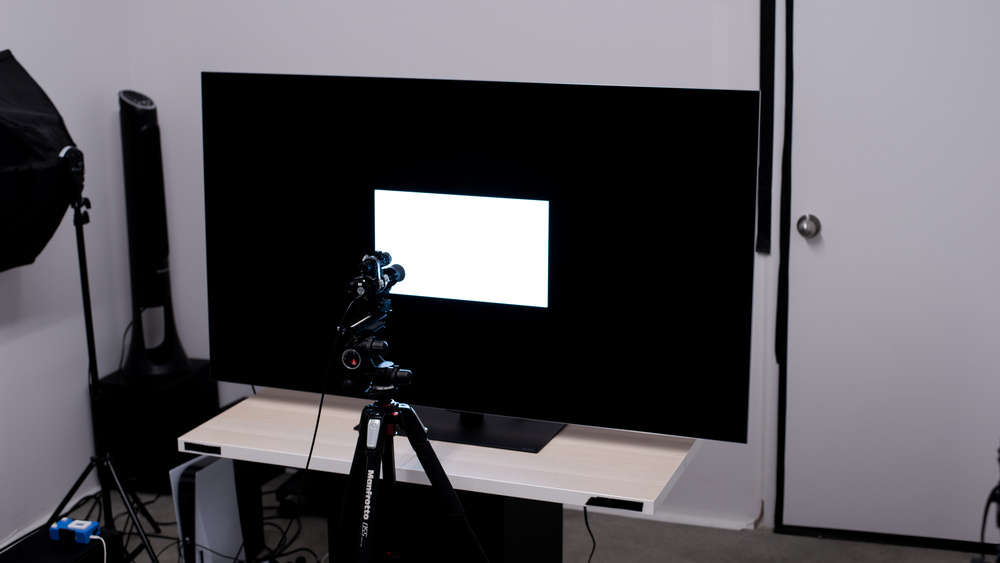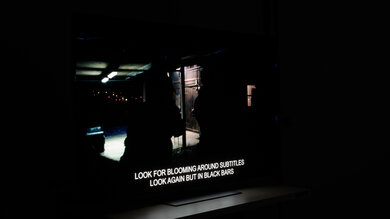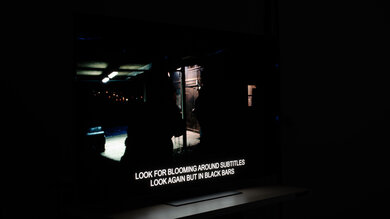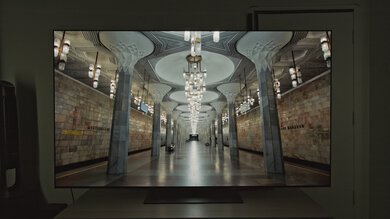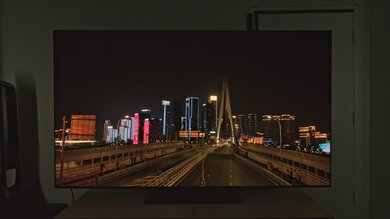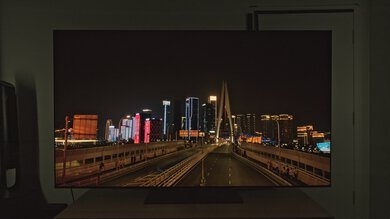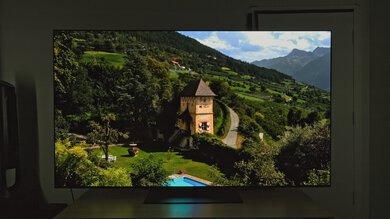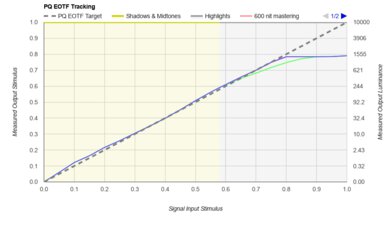The LG G4 OLED is LG's flagship 4k TV for 2024. It replaces the LG G3 OLED and sits above the LG C4 OLED. Like its predecessor, it uses Micro Lens Array (MLA) technology for better brightness than typical WOLED panels, but unlike the G3, this year's 83-inch model also includes MLA, although the super expensive 97-inch model doesn't. It's available in five sizes: 55-inch, 65-inch, 77-inch, 83-inch, and a massive 97-inch model. Unlike its predecessor, the 55-inch and 65-inch models now include a stand in North America, but the 77-inch, 83-inch, and 97-inch models still come with LG's Slim Wall Mount. It uses the 2024 version of LG's webOS, and the TV has 60W 4.2 channel speakers built-in that can be virtually up-mixed to 11.1.2 using the α11 AI Sound Pro feature.
Our Verdict
The LG G4 OLED is incredible for mixed usage. If you regularly watch movies in a dark room, the TV's remarkable contrast and amazing HDR brightness deliver an impactful HDR experience, but it's also suitable for use during the day or with the lights on due to its ability to overcome glare. The TV's incredibly wide viewing angle makes it a great option for watching sports or TV shows with a group, and it also has a nearly instantaneous response time for clear motion, which makes it fantastic for playing video games or watching sports. If you're a console or PC gamer, this TV is a remarkable choice due to its advanced gaming features.
-
Near-infinite contrast ratio for perfect blacks with no blooming around bright highlights.
-
Incredibly wide viewing angle for a consistent image from the sides.
-
Impressive SDR brightness and exceptional reflection handling makes it suitable for a bright room.
-
Nearly instantaneous response time for no noticeable blur behind fast motion.
-
Colors are vibrant, lifelike, and bright.
The LG G4 OLED is amazing for watching TV shows. The TV's impressive SDR brightness and exceptional reflection handling make it suitable for use in a bright room since it overcomes glare. It's also an incredible option for watching shows with friends due to its wide viewing angle, so anyone watching from the sides will see a consistent image. The built-in webOS is loaded with streaming apps, so it's very easy to find the newest hit shows. If you regularly watch shows on DVD or from low-quality streams, this TV is very good at upscaling low-resolution content and does an excellent job of smoothing out low-quality content.
-
Incredibly wide viewing angle for a consistent image from the sides.
-
Impressive SDR brightness and exceptional reflection handling makes it suitable for a bright room.
-
Excellent image processing with low-quality and low-resolution content.
The LG G4 OLED is fantastic for watching sports. Its incredibly wide viewing angle makes it suitable for watching the game with friends, as anyone sitting to the sides of the screen will still see a consistent image. It's also suitable for use in a bright room as it overcomes glare due to its exceptional reflection handling and impressive SDR brightness. If you watch sports like football and hockey that have large areas of uniform colors, you won't be distracted by the dirty screen effect due to the TV's excellent uniformity. On top of that, there's no noticeable blur behind quick-moving players and objects due to the TV's nearly instantaneous response time.
-
Incredibly wide viewing angle for a consistent image from the sides.
-
Excellent gray uniformity with no noticeable dirty screen effect.
-
Impressive SDR brightness and exceptional reflection handling makes it suitable for a bright room.
-
Nearly instantaneous response time for no noticeable blur behind fast motion.
-
Excellent image processing with low-quality and low-resolution content.
The LG G4 OLED is remarkable for playing video games. Enabling Game Optimizer doesn't have any noticeable effect on image quality, so you don't have to worry about a worse overall picture if you want the best performance while gaming. There's no noticeable blur behind fast motion due to the TV's nearly instantaneous response time, and its exceptionally low input lag delivers a responsive gaming experience with no noticeable delay between your controller inputs and the action on screen. The TV looks remarkable with deep and inky blacks in a dark room due to its nearly infinite contrast ratio, but it's also suitable for use in a bright room due to its impressive SDR brightness and exceptional reflection handling. It has HDMI 2.1 bandwidth on all four of its ports and supports up to 4k @ 144Hz with VRR, so it's a fantastic option to pair with modern consoles or modern gaming PCs.
-
HDMI 2.1 bandwidth on all four ports.
-
Exceptionally low input lag for a very responsive experience.
-
Impressive SDR brightness and exceptional reflection handling makes it suitable for a bright room.
-
Nearly instantaneous response time for no noticeable blur behind fast motion.
The LG G4 OLED is outstanding for watching movies in a dark room. The TV removes 24p judder from any source, so movies are judder-free regardless of how you watch them. The TV's remarkable contrast and incredible black uniformity deliver deep, inky blacks with no blooming when bright highlights are on screen, so it looks superb in a dark room. Bright highlights really pop due to the TV's amazing HDR brightness, so you get an impactful HDR experience. This TV has an excellent wide color gamut and impressive color volume, displaying vibrant, lifelike, and bright colors. Finally, it has incredible SDR pre-calibration accuracy, so if you care about accuracy in SDR, there's no need to get the TV calibrated.
-
Near-infinite contrast ratio for perfect blacks with no blooming around bright highlights.
-
Removes 24p judder from any source.
-
Colors are vibrant, lifelike, and bright.
-
Amazing HDR peak brightness that makes highlights pop.
-
Dolby Vision Support.
-
DTS Audio Support.
-
Noticeable stutter due to the TV's fast response time.
-
Aggressive ABL can be distracting with large areas of brightness.
The LG G4 OLED is outstanding for playing video games in HDR. It has HDMI 2.1 bandwidth on all four of its ports for up to 4k @ 144Hz, so it's a fantastic option to pair with modern gaming consoles or PCs. It also supports VRR for a nearly tear-free gaming experience, has exceptionally low input lag for a responsive gaming experience with no noticeable delay between your controller inputs and what happens on screen, and displays fast motion with no noticeable blur due to its nearly instantaneous response time. Its remarkable contrast delivers deep and inky blacks when gaming in a dark room, and highlights really pop due to the TV's amazing HDR brightness.
-
Near-infinite contrast ratio for perfect blacks with no blooming around bright highlights.
-
HDMI 2.1 bandwidth on all four ports.
-
Exceptionally low input lag for a very responsive experience.
-
Nearly instantaneous response time for no noticeable blur behind fast motion.
-
Colors are vibrant, lifelike, and bright.
-
Amazing HDR peak brightness that makes highlights pop.
-
Dolby Vision Support.
-
Aggressive ABL can be distracting with large areas of brightness.
The LG G4 OLED is exceptional for use as a PC monitor. The TV has an incredibly wide viewing angle, so you can sit close to the screen, and the edges will remain consistent with the center. It's suitable for use in a bright room due to its impressive SDR brightness and exceptional reflection handling, so it overcomes glare, and its excellent uniformity means you won't be distracted by the dirty screen effect when looking at large areas of uniform color, like when browsing the web. There's no noticeable blur behind quick cursor movements or when scrolling through pages due to the TV's nearly instantaneous response time, and you get a very responsive desktop experience due to its exceptionally low input lag. The TV properly displays chroma 4:4:4 from a PC, which is essential for clear text. Unfortunately, due to its WRGB subpixel layout, there are still minor clarity issues with text, although most people won't be bothered by it.
-
Incredibly wide viewing angle for a consistent image from the sides.
-
HDMI 2.1 bandwidth on all four ports.
-
Exceptionally low input lag for a very responsive experience.
-
Excellent gray uniformity with no noticeable dirty screen effect.
-
Impressive SDR brightness and exceptional reflection handling makes it suitable for a bright room.
-
Nearly instantaneous response time for no noticeable blur behind fast motion.
-
Risk of permanent burn-in.
-
Text visibility issues due to the TV's WRGB subpixel layout.
- 9.2 Mixed Usage
- 8.9 TV Shows
- 9.0 Sports
- 9.5 Video Games
- 9.2 HDR Movies
- 9.2 HDR Gaming
- 9.6 PC Monitor
- Updated Apr 25, 2024: Review published.
- Updated Apr 22, 2024: Early access published.
- Updated Apr 15, 2024: Our testers have started testing this product.
- Updated Apr 08, 2024: The product has arrived in our lab, and our testers will start evaluating it soon.
- Updated Mar 18, 2024: We've purchased the product and are waiting for it to arrive in our lab.
Differences Between Sizes And Variants
We bought and tested the 65-inch LG G4 OLED (OLED65G4SUB), but it's also available in 55, 77, 83, and 97-inch sizes. The massive 97-inch model doesn't have the MLA focusing layer, so it isn't as bright as the smaller models. Note that the last three letters in the model number (SUB and WUA in this case) vary between retailers and individual regions, but there's no difference in performance. In the UK, you can also get the 55-inch and 65-inch models with a wall mount (LW) instead of a stand (LS).
| Size | US Model | UK Model | Stand or Wall Mount | MLA |
|---|---|---|---|---|
| 55" | OLED55G4SUB | OLED55G46LS | Stand | Yes |
| 65" | OLED65G4SUB | OLED65G46LS | Stand | Yes |
| 77" | OLED77G4WUA | OLED77G45LW | Slim Wall Mount | Yes |
| 83" | OLED83G4WUA | OLED83G45LW | Slim Wall Mount | Yes |
| 97" | OLED97G4WUA | OLED97G45LW | Slim Wall Mount | No |
Our unit was manufactured in March 2024; you can see the label here.
Compared To Other TVs
The LG G4 OLED is an incredible TV and one of the best OLEDs on the market. It increases the maximum refresh rate to 144Hz, is brighter overall than the G3, and has less banding. Unfortunately, it's also currently a lot more expensive than its predecessor. Unless you need the small upgrades that it brings with it, your money is better spent on the cheaper LG G3 OLED while it's still available. If you want similar performance but don't need the extra brightness, the cheaper LG C3 OLED or the LG C4 OLED are very similar in most other categories.
For more options, check out our recommendations for the best OLED TVs, the best gaming TVs, and the best TVs for watching movies.
The LG G4 OLED and the LG G3 OLED are very similar TVs overall, but the G4 is a bit better. The G4 gets brighter in HDR, so highlights stand out more on it, and it also maintains its brightness much better in Game Mode, so you don't have to trade in performance if you don't want a decrease in brightness. On top of that, the G4 has better HDR native gradient handling, so there is less banding in colors, and it supports 144Hz, so it's better for PC gamers looking to take advantage of their high-end graphics cards.
The LG G4 OLED is better than the LG C3 OLED. The G4 gets brighter overall, so it overcomes more glare in a bright room while watching SDR content, and highlights pop more in HDR content. The G4 also maintains its HDR brightness much better in Game Mode, so you don't have to trade in brightness for performance when gaming. The G4 has better color volume, so it can display colors brighter, and there is less banding in colors. Finally, the G4 supports up to 4k @ 144Hz, so it's the better option for PC gamers with high-end graphics cards.
The Samsung S95D OLED and the LG G4 OLED are both top-notch TVs, but there are some differences. The LG gets brighter in SDR, so it overcomes more glare in a bright room while watching SDR content. The LG is the better option if you regularly watch low-quality streams or DVDs since its low-quality content smoothing does a better job. The LG supports Dolby Vision and DTS audio, so it's the better option for those who collect 4k Blu-rays or for those who want to take advantage of Dolby Vision from their favorite streaming apps. On the other hand, the QD-OLED panel on the Samsung provides a wider color gamut and better color volume, so colors are more vibrant, lifelike, and brighter in HDR content. The Samsung includes the Slim One Connect Box, which is good for those looking for a versatile way to plug in their devices, and its matte coating does a better job at eliminating reflections in a bright room, albeit at the cost of image quality.
The Sony A95L OLED and the LG G4 OLED are both incredible TVs, but there are some differences. The LG gets a bit brighter overall, so highlights stand out a bit more in HDR content, and it overcomes a bit more glare when watching SDR content in a bright room. The LG also maintains its brightness better in Game Mode, so you don't have to trade in brightness for performance. The LG is better for gaming overall due to its HDMI 2.1 bandwidth on all four ports, up to 4k @ 144Hz, and lower input lag. On the other hand, the Sony can display more vibrant, lifelike, and brighter colors due to its wider color gamut and better color volume, and there is less banding in most colors.
The LG G4 OLED and the Samsung S90D/S90DD OLED are both amazing TVs, but there are some differences worth noting. The Samsung has a wider color gamut, so it can display more vibrant and lifelike colors, and it has better color volume, so it can display brighter colors. The S90D also has no noticeable banding in colors, while the LG does have some banding in certain colors. On the other hand, the LG has better low-quality content smoothing, so it's the better choice if you regularly watch DVDs or low-quality streams. The LG also supports both Dolby Vision and DTS audio formats, which is great if you're looking to get the most out of your 4k Blu-ray collection. On top of that, the LG has better SDR brightness, so it overcomes more glare in a bright room.
The LG G4 OLED is a lot better than the LG B3 OLED. The G4 has HDMI 2.1 bandwidth on all four of its ports, it supports up to 4k @ 144Hz, so it's more versatile if you own multiple devices that need high bandwidth, and it's better for PC gamers with high-end graphics cards. The G4 gets a lot brighter overall, so highlights in HDR content really stand out on it, and it overcomes more glare in a bright room while watching SDR content. You also don't have to trade in brightness for performance on the G4 since it maintains its HDR brightness much better while in Game Mode.
Test Results
The LG G4 OLED has a very sleek and modern design. It's essentially the same as last year's LG G3 OLED, with very thin bezels and a flat side profile, which means it's completely flush when wall-mounted.
Unlike the G3, a stand is included with the 55-inch and 65-inch models in North America, so you don't have to purchase a third-party stand if you don't plan on wall-mounting it. In some other regions, you can get the 55-inch and 65-inch models with either a stand or a wall mount.
The stand is small but is made from metal, and although there's a bit of wobble when the TV is pushed on, it recovers quickly and doesn't cause any issues. The stand can be adjusted to two different positions. The low position lifts the TV about 2.28", which brings the screen very close to your table. The high position lifts the TV about 3.94", so most soundbars fit underneath without blocking the screen.
Footprint of the 65-inch stand: 19.1" x 10.4".
The back of the TV has a very clean and minimalistic look. It's made of textured metal with a metallic silver border at its edges. There are recessed cutouts in the back that can be used to funnel cables through, and those cables can be funneled through the intuitive stand for cable management. If you want to wall-mount the TV, you can still do so, but the 55-inch and 65-inch models don't come with LG's Slim Wall Mount.
The LG G4 is an OLED and doesn't have a backlight, so its self-lit pixels give it the same performance as a TV with perfect local dimming and no zone transitions. We still film the zone transition video on the TV so you can see how it compares to a TV with local dimming.
The LG G4 OLED has amazing HDR brightness. It gets bright enough for highlights to pop and delivers an impactful HDR experience. Unfortunately, large bright scenes are significantly dimmer than smaller, specular highlights due to its aggressive Automatic Brightness Limiter (ABL).
These measurements are after calibrating the HDR white point with the following settings:
- HDR Picture Mode: Cinema
- OLED Pixel Brightness: 100
- Contrast: 100
- Auto Dynamic Contrast: Off
- Dynamic Tone Mapping: Off
- Expression Enhancer: Off
- Peak Brightness: High
There's no noticeable difference with HDR brightness when the TV is set into Game Optimizer.
These measurements are after calibrating the HDR white point with the following settings:
- HDR Picture Mode: Game Optimizer
- OLED Pixel Brightness: 100
- Contrast: 100
- Auto Dynamic Contrast: Off
- Dynamic Tone Mapping: HGiG
- Expression Enhancer: Off
- Peak Brightness: High
The TV has fantastic PQ EOTF tracking. Some shadows and mid-tones are slightly brighter than intended, but the TV tracks the curve very closely. With content mastered in 600 or 1000 nits, there's a sharp cutoff at the TV's peak brightness, but since the TV is bright enough to display content mastered at those levels, a roll-off isn't necessary. With content mastered at 4000 nits, there's a more gradual roll-off to preserve detail in very bright highlights.
The LG G4 OLED has impressive SDR brightness, and it gets bright enough to overcome glare in a bright room. The TV's Automatic Brightness Limiter isn't aggressive in SDR, so you don't have to deal with the screen dimming considerably when large areas of brightness are present.
These measurements are after calibration with the following settings:
- Picture Mode: Dark Space, night
- OLED Pixel Light: 100
- Peak Brightness: High
- Color Temperature: Warm 50
The LG G4 TV has an excellent color gamut. It has outstanding coverage of the DCI-P3 color space used in most HDR content, with good coverage of the wider Rec. 2020 space, which is increasing in popularity. Colors are very close to the mark in the DCI-P3 color space, with reds and greens being a bit undersaturated. Colors are more off in the Rec. 2020 color space, with all colors being undersaturated.
The LG G4 OLED has impressive color volume. It displays dark, saturated colors very well, and its ability to display bright whites is unrivaled. It doesn't display other colors as brightly as it does whites, but it's still enough to display bright and vibrant colors with impact.
With the TV set to Game Optimizer, there's no visible difference in color luminance, and you can see the measurements below.
- White Luminance: 1481 cd/m²
- Red Luminance: 140 cd/m²
- Green Luminance: 431 cd/m²
- Blue Luminance: 49 cd/m²
- Cyan Luminance: 469 cd/m²
- Magenta Luminance: 179 cd/m²
- Yellow Luminance: 549 cd/m²
The LG G4 has incredible pre-calibration accuracy. The white balance and color accuracy is superb, with no noticeable issues at all. Color temperature is only slightly warmer than our target of 6500K, and gamma is very close to our target of 2.2, with only very bright scenes being a bit too bright.
After calibration to the D65 white point, the TV has exceptional accuracy. The white balance is essentially perfect, and color accuracy is even better than before. Gamma is also nearly perfect, with all scenes being displayed properly, and color temperature is very close to our target of 6500K.
You can see our full calibration settings here.
The TV has exceptional reflection handling. Its glossy screen finish significantly reduces the intensity of direct reflections and does an excellent job of reducing the intensity of indirect reflections.
The TV has great HDR native gradient handling. There's some noticeable banding in dark grays, but all other colors have minimal banding or no banding at all.
The LG G4 does a very good job at upscaling low-resolution content like DVDs or lower-resolution streams. Details are clear enough, but very fine details are hard to make out.
Sharpness processing was calibrated with no over-sharpening for low-resolution content, with the following settings:
- Sharpness: 17
- Super Resolution: Off
The LG G4 TV uses a WOLED panel with a WRGB pixel structure where all four pixels are never lit at the same time. Due to its subpixel layout, it has minor issues with displaying text on Windows since ClearType isn't well optimized to non-RGB subpixel layouts, but most users won't be bothered by this.
What really separates the TV from other WOLEDs is the use of Micro Lens Array (MLA) technology. MLA acts as a focusing layer in front of the WOLED panel, allowing it to get much brighter without the TV having to run hotter. MLA adds a slight haze to the screen, but the haze isn't noticeable at all when watching the TV. Note that the 97-inch model doesn't have MLA technology.
The TV has a nearly instantaneous response time, resulting in incredibly clear motion with almost no blur behind fast-moving objects. Due to the sample-and-hold nature of OLED technology, there's still some persistence blur when gaming at 60Hz, but it's not noticeable at higher refresh rates.
The LG G4 TV doesn't have a traditional backlight and doesn't use pulse-width modulation (PWM) to dim each pixel, but it's not completely flicker-free. There's a slight dip in brightness that corresponds to the TV's refresh rate. This is very different from the PWM flicker on TVs with LED backlights and occurs on every OLED we've tested. It's not noticeable, and most people won't be bothered by this, but it can still bother people who are extra sensitive to flicker.
The TV has an optional black frame insertion (BFI) feature that reduces the appearance of persistence blur caused by the TV's nearly instantaneous response time. It can only insert black frames at a 60Hz refresh rate.
The LG G4 TV has an optional motion interpolation feature to help improve the appearance of motion. It works well with slower scenes but struggles with fast-moving action, so there's noticeable haloing and artifacts present in busier scenes, especially if you use the settings too aggressively.
Unfortunately, due to the nearly instantaneous pixel response time of the TV, there's stutter with low frame rate content, which is most noticeable during slow panning shots.
The TV removes judder when watching 24p movies or TV shows when the Real Cinema setting is enabled, even from sources that can only send a 60Hz signal, like a cable box. Unfortunately, movies and TV shows aren't judder-free when BFI is enabled because the BFI feature only flickers at 60Hz.
The TV supports FreeSync and HDMI Forum VRR and is certified as G-SYNC compatible, ensuring a nearly tear-free gaming experience from any VRR-enabled source.
The LG G4 has exceptionally low input lag when set to Game Optimizer with 'Prevent Input Delay' set to 'Boost,' resulting in a very responsive gaming experience with very little delay between the actions on your controller and what happens on screen. For chroma 4:4:4 to work properly, the input label must be set to 'PC,' or the '4:4:4 Passthrough' setting must be enabled.
If you're a retro gamer, you can see the input lag results in 4:3 @ 60Hz below.
- 640x480: 27.2 ms
- 800x600: 34.2 ms
- 1024x768: 26.9 ms
- 1280x960: 26.9 ms
The LG G4 supports all common formats, and it displays chroma 4:4:4 properly, which is important for clear text from a PC.
There are two settings you can use to passthrough proper chroma 4:4:4. The first is to change the input label to 'PC,' and the second is to enable the '4:4:4 Passthrough' setting in the 'HDMI Settings' menu. Both of these options work the same and lock you out from using the 'Peak Brightness,' 'Noise Reduction,' 'MPEG Noise Reduction,' 'Smooth Gradation,' and 'Real Cinema' settings.
The TV is fully compatible with everything the PS5 offers, like 1440p @ 120Hz and 4k @ 120Hz, as well as HDMI Forum VRR. It also supports Auto Low Latency Mode, so you don't have to worry about switching to Game Optimizer to get the lowest input lag.
The TV is fully compatible with everything the Xbox Series X|S offers, including 1440p @ 120Hz, 4k @ 120Hz, HDMI Forum VRR, FreeSync Premium Pro, and Dolby Vision gaming. It also supports Auto Low Latency Mode, so you don't have to worry about switching to Game Optimizer to get the lowest input lag.
The LG G4 supports the full 48Gbps bandwidth of HDMI 2.1 on all four HDMI ports. This allows you to take full advantage of multiple high-bandwidth devices, like if you own both current-gen consoles and a high-end gaming PC. Unlike the LG G3 OLED, the LG G4 doesn't support ATSC 3.0 for 4k over-the-air, as LG has dropped that feature on their 2024 models.
The TV supports a ton of audio formats. It supports DTS audio formats, which is great if you like to watch DVDs or Blu-rays, as they often use DTS for their main audio tracks.
The LG G4 OLED TV has a good frequency response. Its sound profile is well-balanced, so dialogue is easy to understand, and unlike most TVs, it actually produces a small amount of bass. The TV doesn't get very loud, but it still sounds good near or at max volume.
The TV runs the 2024 version of LG's proprietary smart interface, webOS. The interface is fast and easy to use, and it supports user profiles, so you can customize the home page for different users.
Unfortunately, the TV has a couple of bugs. Sometimes, the TV doesn't properly switch out of the Game Optimizer setting, so you're locked out of settings that should be available in other picture modes. To fix this, you can turn Game Optimizer on and disable ALLM and VRR. When you do this and switch to a different picture setting, everything works as it should.
The second bug causes the occasional black screen when changing resolutions and refresh rates frequently in a short period of time. The only fix for this is to unplug and re-plug the TV in, but this is unlikely to happen with real-world usage.
There are two settings in the 'Home Settings' menu, namely the 'Home Promotion' and 'Content Recommendation' settings. These settings remove the top banner ads and suggested content from the home screen. This gives your home screen a clean look, but there's no way to remove ads from the apps page.
The LG G4 OLED TV has a great selection of apps, so it's easy to find your favorite content. You can also cast content from your phone onto the TV or play videos from a USB stick.
The LG G4 OLED has the same Magic Remote that came with the LG G3 OLED. The remote can be used as a pointer, or you can use the traditional buttons to control the TV. The TV also supports hands-free voice control through microphones on the TV itself. You can use your voice to change inputs, open apps, search for content, and ask for the weather and time.

